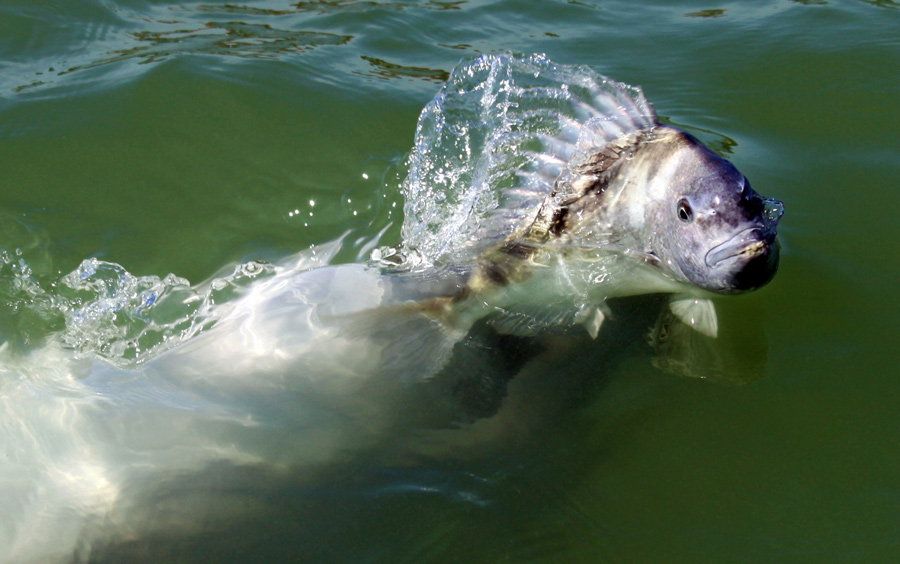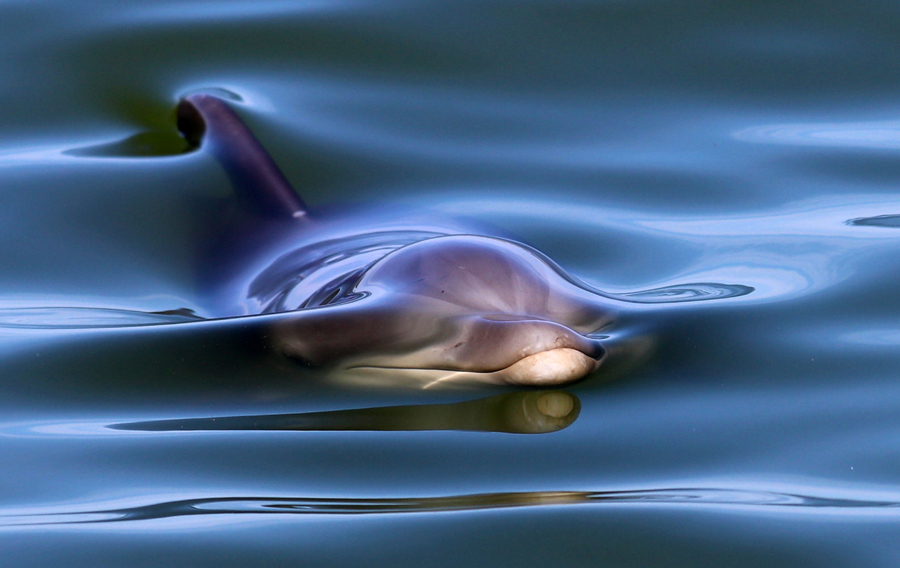Protecting bottlenose dolphins from coastal construction
Bottlenose dolphins (Tursiops truncatus) are the only wild animals who choose to play with as well as help humans. These graceful and sleek swimmers can be very playful and can often be seen leaping out of the water to follow nearby boats. Not only do they have incredible acrobatic skills, dolphins also express complex sets of behaviours, including the practice of controlled conflict, sharing food, using various objects like toys and tools, a wide range of symbolic behaviours, and even on occasion teasing researchers studying them.
Based at Good-Natured Statistics Consulting, USA, biostatistician Professor Ann Weaver is known locally as the Dolphin Lady because she has studied dolphins living free at sea for 20 years. The researcher has witnessed first-hand how these intelligent mammals can change and adapt their behaviour when confronted with a new situation – if given the chance. This includes, for example, self-decorating their dorsal fin with grass to stand out in large groups, developing empathy and reconciling with other members of the group after a dispute.

Sadly, more and more dolphins also have to deal with urban developments encroaching on their habitat. The accelerating pace of construction in coastal zones has turned these areas into some of the most affected ecosystems on Earth. Noise pollution in particular is a serious issue for cetaceans: these animals depend on sound to navigate, communicate with other dolphins, avoid predators, and search for food. This makes them highly vulnerable to noise. However, research looking at how coastal construction can affect dolphins is limited and often inadequate, even though it’s urgently needed to protect these marine species.
The bridge
For many years, Weaver has been trying to cover this gap. The perfect research opportunity presented itself in the form of a bridge replacement project over a narrow corridor frequently used by dolphins known as John’s Pass, located on the west-central coast of Florida. The project involved removing the old bridge and building a new one, which included driving countless piles as barge moorings on the east side facing the Intra-Coastal Waterway and the west side facing the Gulf of Mexico. Inevitably, the bridge removal and replacement project involved increased noise levels, illumination, vessel traffic, and various large floating structures that would not be there otherwise.
Dolphins may continue to exist in human-degraded habitats, but that does not mean that construction was neutral.
Most bottlenose dolphins like the familiarity of the same locations year after year, making them particularly vulnerable to long-term disruptions like the ones caused by construction sites. The impact of these human activities on cetacean behaviour is not easy to follow – as most of it happens underwater – but for Weaver, this “bridge construction project over John’s Pass provided the perfect opportunity to document free-ranging bottlenose dolphin behaviour before, during, and after bridge construction”. Weaver drew upon 15 years of intensive studies of peacemaking and social skill development in primates, equipping her with the necessary observational skills and tools to document the often-fast and always complex actions of the dolphins as they occurred.
Females vs males
Initially, Weaver wanted to test whether males and females reacted the same way to the bridge replacement project. “Although a sex difference is predicted by bottlenose dolphin natural history, nothing was known about how sex differences might interact with long-term construction projects in key areas of dolphin habitat”, says the behavioural researcher.

In a nearby project, bridge construction in Sarasota forced local dolphins to disperse, but numbers recovered once the project was completed. In John’s Pass, however, it was a more complex story. The bridge replacement was associated with a steady decline in female sightings, but males continued to feel comfortable enough to visit the area. Before construction, females were spotted twice as often as males, but after a 25% drop during construction and a further 25% reduction after construction, it became just as hard to spot a female as it was to spot a male. Weaver characterised this as a slow, steady leak rather than an abrupt departure from the area, implying that “old habits die hard”.
For Weaver, these results did not come as a surprise. Females with young are likely to be more susceptible to noisy disturbances than males. In fact, females observed abandoning the area were raising at least one calf. The way a dolphin mother and her calf communicate with whistles and other vocalisations is vital to maintaining contact, and anything that interferes with maintaining contact jeopardises calf survival. Weaver’s results suggested that dolphin mothers prefer quieter waters than males to “talk” to their offspring and remain vigilant for predators to protect herself and her calf.
It’s too early to understand what this decline in females will do to the John’s Pass dolphin community. Bottlenose dolphins reproduce slowly, and any effects may not be spotted for years to come. However, losing most of its females is never good for any population in the long term.
Just a little later
After 11 years of sightings along John’s Pass and the surrounding area, it turned out it wasn’t just the ratio of females and males that was affected by this construction. Dolphins had to find new feeding areas outside the construction zone. Sightings near the building works became rare, and the effects continued to be visible for five years after construction had ended. These “habitual creatures only change what human impacts force them to change”, explains Weaver. “When construction destroys their habitat and prey, dolphins can learn to feed elsewhere as long as suitable habitat is available to them”.

Weaver believes this change in eating habits was the result of noisy activities such as pile driving and dredging. Sound from the impact of a hammer hitting a pile causes waves around the piles, transmitting the noise through the water. In fact, as the sound travels down the pile and into the water, it is noisier further from the pile than closer to it. Dredging creates underwater sand storms that suffocate fish. Not surprisingly, these devastating environmental impacts forced the dolphins to look for their next meal somewhere else.
In a domino effect, change in feeding patterns led to a series of other changes. Before construction, it was common to spot as many as 60 dolphins foraging, feeding, and socialising along John’s Pass, sometimes for hours. Weaver documented over 9,000 sightings between 2006 and 2013. Across the year, these dolphins also showed mini-migrations by moving out of the shallow intra-coastal waterways to spend the colder months in deeper waters offshore, before returning during late winter and spring, and occupying their habitual waterways once again by summer.
However, it became increasingly harder to find dolphins during the first phase of construction. The number of these mammals visiting John’s Pass simply dropped, and their routine migration completely disappeared. Dolphins eventually returned during the second construction phase, but they were still wary and cautious. Intriguingly, John’s Pass dolphins learnt to avoid the noise by moving their schedule of travelling and socialising to later in the day, coinciding with quieter periods when construction activities were minimal. “They may continue to exist in human-degraded habitats, but that does not mean that construction was neutral”, explains Weaver.
This matter deserves more attention if we wish to maintain these dolphin populations.
It may sound somewhat strange that dolphins changed their feeding habits but continued visiting the area for social purposes. According to Weaver, it suggests that dolphins may change some of their habits but not others in response to human disruption. On one hand, dolphins were forced to move out of the construction zone to find food because fish numbers were depleted. On the other hand, socialising continued along John’s Pass because there were still dolphins willing to stay in the area. It turned out that feeding was more susceptible to changes in response to the bridge replacement, but since social behaviour may not need a quiet place, theses behaviours may be more resilient to environmental impacts. Weaver’s evidence is the first to suggest that human impacts may not affect all of a species’ behaviours the same way, an important warning to other researchers.

According to Weaver, this means that “the presence of socialising dolphins in construction zones can mislead observers about the true impacts of construction”. For her, it is imperative that other behavioural adaptations are taken into account by researchers to assess the impact of coastal construction projects on coastal cetaceans.
Recommendations for future projects
Based on these observations, Weaver believes it’s vital to monitor every construction project and, if possible, develop a two-part plan to give dolphins a chance to become familiar with construction noises in the first phase and perhaps adapt in the second phase. Along with other researchers, Weaver also stresses that it should be required by law to assess how marine mammals and fish communities use the habitat before any coastal construction project can start.
These evaluations can then be used to identify and protect alternative habitats nearby, giving the animals a safe haven away from noisy dredging, pile driving, and explosions. “Construction noise above ambient levels was not measured in the current study, but it clearly occurred”, says Weaver. “Acoustic data are needed on construction-induced changes to the ambient acoustic environment to understand how such changes may compromise vital ecological conditions”.
These suggestions are particularly relevant, as the US Department of Transportation’s Federal Highway Administration has a list of over 4,000 bridges in Florida that need urgent repair work. This means it’s highly likely that further construction projects will take place in waters where dolphins abound. “This matter deserves more attention if we wish to maintain these dolphin populations”, concludes the researcher.
Personal Response
Drawing upon findings of your research, you’ve made recommendations for protecting bottlenose dolphins from coastal construction. What needs to happen to enable such recommendations to be implemented?
<>
Responsible stewardship of the Earth is needed. Implementation requires specifically ear-marked funds from governments and construction companies to pay for data on every coastal construction project. The cost of securing sound scientific guidance before coastal construction starts is a fraction of lost tourism dollars when, without science, wildlife is gone when construction ends, and so are the tourists. Science pays dividends.
You’ve spent many years investigating dolphins and dolphin behaviour. What first sparked your interest in this fascinating creature?
<>
I love watching animals behave naturally in nature. If I were as interested in human cultures as I am in animal cultures, I would be an ambassador. Dolphins initially intrigued me for their startling intelligence in a world that requires only the brains of a barnacle. As we crowd the coastlines at a frantic pace, I think, “What an ungracious way to say ‘Thank You’ to the only animals who come out of nature freely to try and save people from drowning and from sharks”.